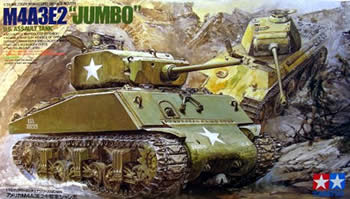|
M4A3E2
"Jumbo" |
 |
|
Known by modelers as the Jumbo, the "assault" Sherman fielded by the US Army in late 1944 was a expedient, stopgap assault tank. It was officially designated M4A3E2 and there were only 254 of these made. They proved extremely useful in the fighting along the German borders in the fall of 1944. Initially, the US Army had been tinkering with numerous designs for a heavy tank. The T14 assault tank was the latest of the these designs, but it was never really needed by the Armored Force. When the fighting became difficult due to resistance and worsening weather conditions, the U.S. troops were in need of tanks that could withstand additional punishment. The T26 series was a solution but it would take some time for them to be completed. So the M4A3 was selected as the basis for an uparmored version of the venerable Sherman. The Sherman was fitted with a new turret, resembling the T23 turret as fitted to the 76mm gunned tanks. The sides of the hull and front glacis had additional armor plates fitted and the transmission cover was also strengthened. All this amounted to a Sherman capable of withstanding a lot of abuse. There are two photos in Concord's U.S. Tank Battles in Germany, showing an M4A3E2 of the 743rd Tank Battalion at Fronhoven. This tank was hit by eight 88mm rounds after becoming immobilized by a mine. But aside from one round penetrating just above the sponson line, the other rounds did not penetrate. The
Kit Because of the "air" the Jumbo has, it's been a popular modeling subject. Despite that, it's not been a popular manufacturers choice, with the only mainstream plastic kit being the old Tamiya kit from the 1980s. As can be expected, Tamiya used their good M4A3 as a basis, providing extra armour for the hull sides and a new turret. But let's take a closer look at what's in the kit. All the basic downsides of Tamiya Shermans are present, so this means the tweaks list is required: no sponsons, no raised hull welds, basic bogie details, heavy exhaust deflector, no straps on the OVM tools, molded on grab handles, etc. Unfortunately, the distinctive changes for the Jumbo do not come off well, so there's more work to do:
ConclusionSo these are the main quirks of this oldie. A lot of work can be done, and has to be done if you want an accurate Jumbo. Personally, I don't think it's worth the money. There are other and better options available. I mentioned the Blast Models conversion set, and this is the best one around. It features a complete upper hull, accurate turret, and very good details. It does need the Tamiya M4 kit, because this has the correct D38501 wheels. More details can be seen at Perth Military Modelling Site. DML released a very good M4A3(76)W kit in 2005. This includes a lot of parts needed for the Jumbo, including correct wheels, suspension and a set of tracks with duckbills included. You'll have to provide your own turret still, plus the side armor and transmission cover. But the basic kit is good. Perhaps or Blast might release a conversion for this kit one day? Or maybe DML will do the complete kit? Aftermarket AccessoriesOf course, most sets for the Sherman series are applicable to the Jumbo: think resin tools (Formations, CMD), new machine guns (Adlers Nest, Academy), new hull hatches (TMD), new turret cupola (Formations, TMD), etc. One place where aftermarket is more wanting is decals. There are several sets of aftermarket decals covering U.S. armor. Two of these have specific markings for the M4A3E2. This includes the Bison Decals set BD-35031. Called "Sherman Mix," it has markings for Cobra King. This was the first Sherman of 37th Tank Battalion into Bastogne. The set has been revised, including decals for updating DML's M4A3E8 kit. The Bison Decals set "Hanks Tank" includes markings for Aquino, a 76mm-armed M4A3E2 from 15th/6th Armored Division. References
-Martin Dogger- |
 |
 |
 |
 |
 |
 |
 |
 |
 |
 |
 |
 |
|
 Tamiya
Tamiya